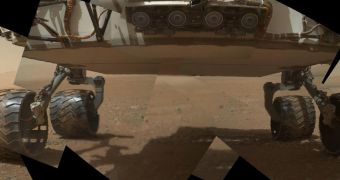Between September 7-9, the Mars Science Laboratory (MSL) rover Curiosity was put through a series of tests meant to assess the mobility of its 2.1-meter (7-foot) robotic arm. One of the main instruments on the arm, the Mars Hand Lens Imager (MAHLI), was activated and tested as well.
During the tests, the arm was moved in a variety of patterns, as investigators from the NASA Jet Propulsion Laboratory (JPL), in Pasadena, California, ran through a rather long checklist. Another goal of the maneuvers was to determine the precision of the arm's motions.
MAHLI was found to be in perfect health, so it was used to snap a series of pictures of the rover's body, its robotic arm and its wheels. The procedure was repeated whenever the arm changed its position.
Scientists gathered enough data to compile a profile of the way the robotic arm moves. The tests are being conducted ahead of a planned arrival at Glenelg, the rover's first science target. The location lies around 400 meters (1,300) from Bradbury Landing, where Curiosity first touched down on Mars.
This location was selected because it contains three different types of rocks, and should therefore make for an interesting first study. The rover stopped along the way so that it could commission its remaining instruments, the one which were not turned on the first few days after landing.
During its commissioning phase, the instrument took images of the MastCam instrument, Curiosity's most keen eyes, of the rover's underbelly and wheels, as well as the MAHLI calibration chart, which is stamped on the body of the rover itself.
“Wow, seeing these images after all the tremendous hard work that has gone into making them possible is a profoundly emotional moment. It is so exciting to see the camera returning beautiful, sharp images from Mars,” says Ken Edgett.
The expert holds an appointment as the principal investigator for the MAHLI instrument, and is based at the Malin Space Science Systems, in San Diego, the company which constructed the camera.
One of the calibration targets the instrument uses is a 1909 Lincoln penny, which Edgett himself purchased specifically for this purpose. “We're seeing the penny in the foreground and, looking past it, a setting I'm sure the people who minted these coins never imagined,” he says.
“The folks who drive the rover's arm and turret have taken a 220-pound arm through some very complex tai chi, to center a penny in an image that's only a few centimeters across. They make the impossible look easy,” adds Aileen Yingst.
The expert is the deputy principal investigator for MAHLI, and is based at the Planetary Science Institute, in Tucson, Arizona.

 14 DAY TRIAL //
14 DAY TRIAL //